Black
Horse Lane
Black Horse Lane is described as an intramural lane in that it
is within the ancient defences, its northern end entering Westgate
Street inside the Old Bar Gate, otherwise the West Gate (see also Lady Lane). In the 18th century it was known
as Gaol Lane, relating to the gaol built into the West Gate and a later
gaol erected around the site of the New Wolsey Theatre. The narrow
alleyway, today called Black Horse Walk,
drops southwards and widens
into Black Horse Lane to end at a wide junction with Elm Street to the
west (and what would once have been Mount Street to the east). Having
noted that Black Horse Lane (and its continuation, Curriers Lane) was
on the inside of the medieval ramparts, a similar trajectory was once
found in Lady Lane which dropped down to
The Mount and continued as Tanners Lane, both lying on the outside of
the rampart. Some of the rows of cottages and courts at the lower end
of Lady Lane were raised two or three feet above the lane on the strip
of land called a Carnser between it and
Black Horse Lane; this was the remains of the
medieval earthen rampart. Looking at maps of Ipswich up to the present
day, you can trace some of these double streets either side of the line
of the
rampart most noticeably from Major's Corner westwards (Old Foundry Road
and Tower Ramparts on the inside, St Margarets Street/Crown Street on
the outside). The demolitions and dual carriageway of Civic Drive and
construction of the Civic Centre in the 1960s obliteratd most of Lady
Lane and all of Tanners Lane.
Detailed maps from 1902 of this area can be found on our Civic Drive page.
Wolsey's birthplace?
So The Black Horse is within the line of the original rampart of the
town. Not only that, but some commentators claim that The Black Horse
building could stand on the site of
the birthplace of Thomas Wolsey (c.1473-1530).
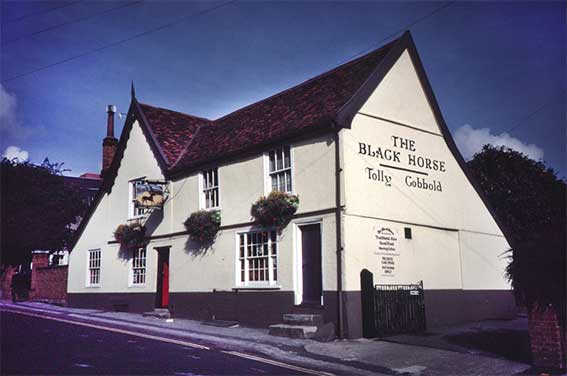 Photo courtesy The Ipswich Society Image
Archive
Photo courtesy The Ipswich Society Image
Archive
Above: The Black Horse public house,
23 Blackhorse Lane, Ipswich in October 1984. Front/side view, with name
lettering on the gable.
The Black Horse is Listed Grade II: 'A C16 timber-framed
and
plastered building with a cross wing at the north end and a wing
extending east at the rear. It was altered in tile C18 and later. The
first storey was jettied originally but was later built out in brick,
probably in the C16, now painted.' The Suffolk CAMRA website (see Links) tells us that it was originally a
merchant's house, it
did not become a public house until after 1689; a Tudor doorway
survives within the remaining building with Jacobean workmanship. This
suggests that there was an earlier building here which could date back
to the time of Wolsey's family. CAMRA continues – Black
Horse: 'Although the building has been a pub "only" since about 1689,
it was standing for some time before that; historians believe that
Thomas Wolsey was possibly born here in approximately 1473.’
The Black Horse, or its predecessor merchant's house, would have
had spacious grounds, surrounded by open fields and meadowland and with
an uninterrupted view of the River Gipping from its raised location.
Difficult to believe today. So, the big question remains: was Thomas
Wolsey born here, or across the road from Curson Lodge – the plaque is
shown on our Plaques page.
The Black Bell?
One source (we can't now track it down) gave an alternative birthplace
for Wolsey as the Black Bell pub at 34 Museum Street and later in Elm
Street. Museum Street wasn’t constructed until 1847. Looking at
Joseph Pennington's 1778 map of Ipswich with the 1902 map overlaid
(shown on our Museum Street
page) you can see The Black Bell just to the left of the
pointed bit of Elm Street – it is just to the west of where Museum
Street would be cut through. The invaluable Suffolk CAMRA website only
traces it back as far as 1769, however, if you’ve found that it’s much
earlier, so be it. David Kindred’s Ipswich:
lost inns, tavern and
public houses (see Reading list) has
it mentioned in The Ipswich Journal
in 1750. A
postcard shown on the CAMRA website is a photograph of the Black Bell
(surely a Victorian building?) with St
Mary-at-Elms Church in the
background. So it stood on the corner of Elm Street and Museum Street
(now an Art Deco building).
Wolsey's origins
Let's look at four of the many references to Wolsey's origins:-
- 1. 'Thomas Wolsey, son of Robert Wolsey and Joan Daundy
Wolsey, was
born in about 1471. His father was a Yeoman farmer but his mother was a
member of the wealthy and influential Daundy family. His father
ran a tavern in Ipswich before he started trading as a butcher and
cattle dealer in 1473. It is believed his mother's brother, Edmund
Daundy, a successful merchant, paid for his education. He [Thomas]
graduated
with a BA from Oxford University in 1486.' (https://spartacus-educational.com/TUDwolseyT.htm)
- 2. 'Thomas Wolsey (or "Wulcy" as he called himself), was
born between
1471 and 1474 in Ipswich, the son of a prosperous merchant. Fanciful
legend has always maintained that Wolsey was the son of a simple
butcher, but there is no factual basis to bear this out.
- Butcher or not, his father Robert could afford to send
Thomas to be
educated at Oxford University, where he was granted his degree at the
tender age of only 15, a feat which earned him the sobriquet "the boy
bachelor". In 1497 Wolsey was voted a full fellow (roughly equivalent
to a modern professor) at Magdalen College. Shortly thereafter he was
appointed master of the school there.' (https://www.britainexpress.com/History/tudor/wolsey.htm)
- 3. 'Thomas Wolsey was born to a substantial butcher and
grazier in
Ipswich and attended the monastery school there before going to
Magdalen College Oxford.' (https://www.tudortimes.co.uk/people/thomas-wolsey)
- 4. In Robert Malster’s A
history of
Ipswich (see Reading list) – usually a
most reliable of source, but the book is now twenty years old) – Bob
says that: ‘His birthplace was almost certainly a house in St Nicholas
Street, long since demolished, at the corner of a passage through into
the churchyard [presumably St Nicholas Church Lane?]’. Which takes us
back to the statement on the information plaque on Curson Lodge.
Bob Malster goes on to mention the legal scrapes of Robert Wolsey (e.g.
selling
bad meat at the market) – documents which can be found in the Borough
archives, now housed at Suffolk Record Office. Was Thomas's father a
slightly dodgy but successful businessman. It would seem most likely
that the family of Thomas's mother, Joan Wolsey (neé Daundy), is
crucial. Edmund Daundy, Thomas’s uncle gave the Market Cross to the
town and the Daundys (or Dandys) were one of the wealthiest and
influential families in the town. It may well be that Edmund Daundy
took the child prodigy Thomas under his wing and ensured his place at
Oxford.
We wonder if the notion of The Black Horse Inn being the birthplace of
Wolsey is something we rather want to believe. Black Horse Lane had at
least two previous names (see Street name
derivations) and the inn itself was built (probably) in the
mid-16th century. ‘Like many inns, it was once the house of a wealthy
merchant and became a public house in the 18th century’. So, unless the
(probably Tudor) merchant’s house was built on the site of an inn, are
we saying that Thomas was born in a merchant’s house? This doesn’t fit
with the apparent ‘humble beginnings’ of the Cardinal; however,
accounts of
his origins are varied and often questionable.
In 1917 local historian, Vincent Redstone, published a paper Wulcy of Suffolk for the
Suffolk Institute of Archaeology and Natural History (see Links); this
analyses the source documents relating to the origins of Wolsey and
challenges some of the oft-propagated stories about him.
We are grateful to an enquiry in November 2020 from Philip Roberts
about Wolsey's birthplace, which has caused this first attempt to
answer the question.
Carol Twinch in Ipswich Street by
street (see
Reading list) reminds us that
there is also a connection between the Black Horse Inn and Margaret
Catchpole, because her brother
Charles enlisted in the 33rd Regiment of Foot here.
St Mary-at-Elms Cottage
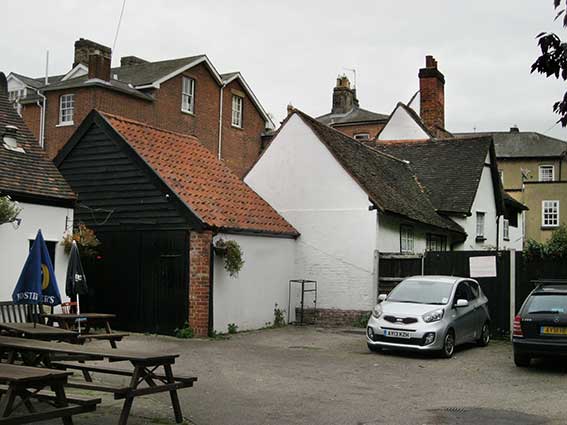 2015 images
2015 images
This photograph from the yard of The Black Horse shows the
relationship with the 15th century cottage behind St Mary-at-Elms Church (see that page for
the Listing text), in fact it is conjoined with one of the pub's
out-buildings.
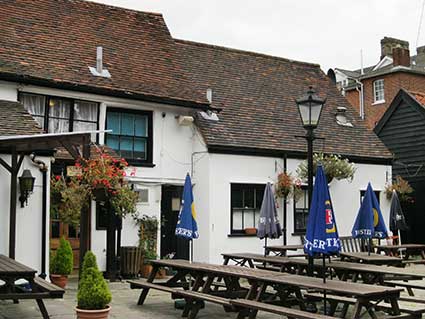
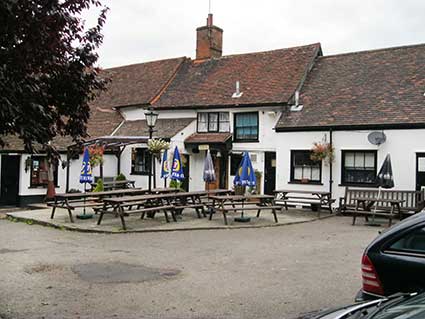
The view of the rear from the car park/beer garden area shows
the crossway (which sits at right-angles to Black Horse Lane) and the
sections which have been added over time to extend the pub to an
'L'-shape.
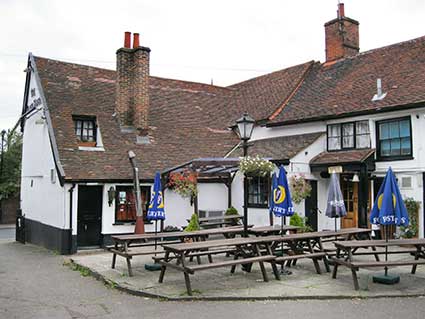
Home
Please email any comments
and contributions by clicking here.
Search Ipswich
Historic Lettering
©2004 Copyright
throughout the Ipswich
Historic Lettering site: Borin Van Loon
No reproduction of text or images without express written permission
 Photo courtesy The Ipswich Society Image
Archive
Photo courtesy The Ipswich Society Image
Archive 2015 images
2015 images

